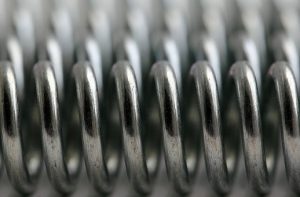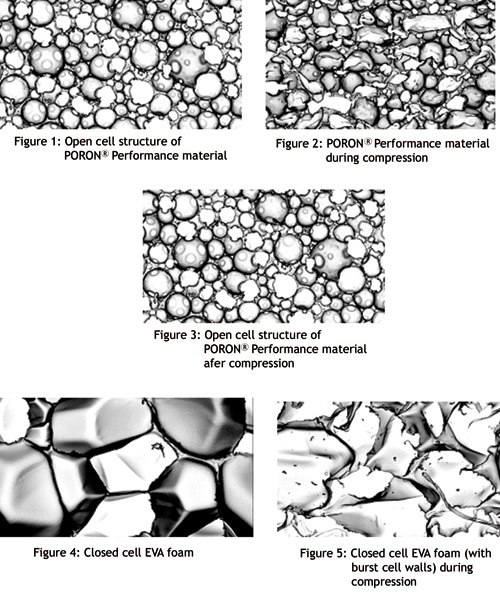
Published
by Dave Sherman
Elastomeric Material Solutions
This post (originally by Dave Sherman) appeared on the PORON Cushioning Blog. Updated 08/21/2018
A Foam is a Foam is a Foam, Right?
In a word (or three), not so much. Our customers are often surprised to learn that all PORON® Comfort materials are open cell polyurethane foams, especially when what they’re used to seeing are closed cell EVA foams or closed cell polyurethane foams.
Open cell foam has many benefits and properties not present in closed cell foams. One of the biggest is that it offers the best resistance to compression set (C-Set) or, for the non-foam aficionados out there, resistance to break down after multiple uses. Essentially, this means that the foam is very durable and won’t break down or lose its cushioning properties after multiple uses. In the footwear world that equates to a consistent fit, form, and functional level, and maintains the look and feel of the shoe as it was designed.
Closed Cell Foams vs. Open Cell Foams
Here’s something else to consider…
Closed Cell Foam:
Closed cell foams, or EVA foams, are comprised of complete bubbles of air. The bubbles of air are trapped in the foam with cell walls all around that prevent air from escaping. Bunched together like soap bubbles in a bubble bath, the air pockets are crucial to the function of the foam. When the foam is compressed, so is the air inside the bubbles, which allows the foam to spring back when pressure is removed. For this reason, they are often used in shoe insoles and sports padding where resistance and protection are key.
Evidence of this property can be demonstrated with a tennis ball. Tennis balls are known to be bouncy due to the air trapped inside the ball. But once a tennis ball has been used repeatedly the air begins to leak out, causing the ball to lose its springy resistance.
Applying this analogy to closed cell foams, this is the point at which the foam begins to go flat or “take a set” (remember that whole C-Set thing?). That’s why insoles or padding made solely from closed cell foam become less comfortable over time or are less protective on the next hit.
Open Cell Foam:
Open cell foams have their plusses and minuses as well. PORON Comfort materials are comprised of open cells connected by portals which allow air to flow between them.
This means these materials are not dependent upon air bubbles for their properties, but instead on the properties of the materials in their cell walls. Because of this, they react to pressure in a manner similar to that of a spring, returning to an original position after each compression without fail due to air moving freely through the cells. An open cell structure also allows for moisture vapor transmission, helping with breathability and maintaining the environment of the shoe.
Available in an array of proprietary formulations, PORON Comfort open cell materials are engineered to provide specific functionality, providing the right level of support and breathability to the end user throughout the day and over the life of the shoe.
So Which One is Right for Your Application?
There are advantages and disadvantages to each type of foam that should be considered when deciding which one to use. Closed cell foams can be very light, as their cell walls can be very thin, but are usually stiff because of the incompressibility of the air inside them. They can also be better than open cell materials at resisting liquid penetration.
Open cell foams, in addition to being resistant to taking a set, are softer and easier to compress. Their cells also allow for breathability and a better Compression Force Deflective (CFD) or, in other words, a measure of their firmness or load-bearing capacity.
Occasionally the right foam solution is actually a combination of closed cell and open cell materials. Capitalizing on the best of both worlds, some designs layer a closed cell foam and open cell foam, allowing the more flexible open cell layer (such as PORON Comfort) to conform to the shape set into the closed cell material (an EVA for example).
Refer to the table below for a summary of the advantages of each type of foam:
| Foam Properties | Open Cell | Closed Cell | Property Measurement |
| Compression Force Deflective (CFD) | ✓ | Softness/Conformability | |
| Compression Set Resistance | ✓ | Life of Properties | |
| Anti-Microbial | ✓* | Integral Coating | |
| Breathability | ✓ | MVTR-Yes/No | |
| Water Absorption | ✓ | % Uptake After Some Time | |
| Washability | ✓ | Cycles at Setting | |
| Shaping | ✓ | ||
| Flexibility | ✓ |
*Optional additional protection available
Be mindful of these differences as they relate to your application and design. If your application requires lighter weight and washability, opt for a closed cell foam. However, if longevity and reliability are critical to your application, choose PORON Comfort materials as your solution.
Tags:
Footwear, Impact Safety, General Industrial
Comments
Published on Aug 21, 2018


